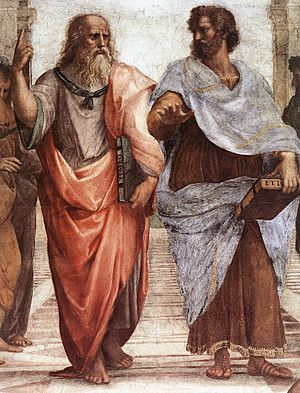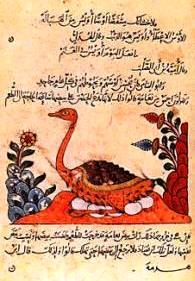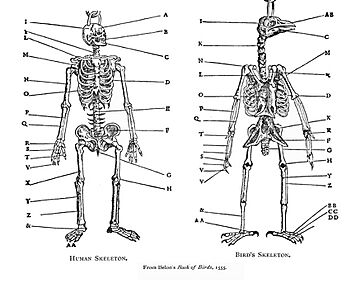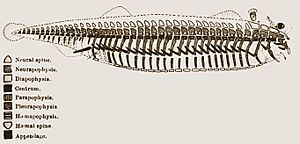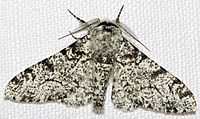History of evolutionary thought facts for kids
Evolutionary thought is all about how people have understood that living things change over long periods of time. It also covers how they've tried to figure out exactly how these changes happen. Ideas about evolution have been around for a very long time, even in ancient Greece, Rome, and China, and in medieval Islamic science.
When modern ways of classifying living things started in the late 1600s, two main ideas shaped how people in the West thought about biology. One was essentialism, which meant believing that every species had fixed, unchangeable features. This idea came from older ways of thinking and fit well with religious views. The other idea was a new scientific approach that focused on how things change. As the Age of Enlightenment progressed, ideas about the universe changing over time spread from physics to natural history. Scientists started looking closely at how much species could vary. Also, the discovery of fossils and the idea that species could go extinct really challenged the belief that nature never changed.
In the early 1800s, before Charles Darwin, a scientist named Jean-Baptiste Lamarck (1744–1829) came up with the first complete theory of evolution. He called it the "transmutation of species."
In 1858, Charles Darwin and Alfred Russel Wallace published a new theory of evolution. Darwin explained it in detail in his famous book, On the Origin of Species (1859). Darwin's theory, originally called "descent with modification," is now known as Darwinism. Unlike Lamarck, Darwin suggested that all living things share a common descent and form a branching "tree of life." This means that even very different species can have a shared ancestor. Darwin based his theory on the idea of natural selection. He brought together lots of evidence from animal breeding, how living things are spread around the world, geology, body structures, and how embryos develop.
Debate over Darwin's work quickly led to the acceptance of the general idea of evolution. However, his specific idea of natural selection wasn't widely accepted until the 1920s to 1940s. Before then, most biologists thought other things caused evolution. During a period called "the eclipse of Darwinism" (around 1880 to 1920), other ideas were suggested. These included the inheritance of acquired characteristics (called neo-Lamarckism), a natural drive for change (called orthogenesis), and sudden, big changes (called saltationism).
In 1900, Gregor Mendel's experiments with pea plants, which showed how traits are passed down, were rediscovered. Scientists like Ronald Fisher, J. B. S. Haldane, and Sewall Wright combined Mendel's ideas with natural selection between the 1910s and 1930s. This led to a new field called population genetics. In the 1930s and 1940s, population genetics joined with other areas of biology. This created a broad theory of evolution that covered much of biology, known as the modern synthesis.
After evolutionary biology became a recognized field, studies of changes in genes (mutations) and genetic diversity in wild populations, along with studies of how living things are spread and classified, led to complex mathematical models of evolution. Paleontology (the study of fossils) and comparative anatomy (comparing body structures) helped scientists reconstruct the evolutionary history of life in more detail.
After molecular genetics grew in the 1950s, the field of molecular evolution developed. This field looked at protein sequences and later RNA and DNA to understand evolution. The idea that genes are central to evolution became popular in the 1960s. Then came the neutral theory of molecular evolution, which said that many genetic changes are random and not caused by natural selection. This sparked debates about how important adaptationism (traits being adaptations), the unit of selection (what evolution acts on), and genetic drift (random changes in gene frequency) are compared to natural selection.
In the late 20th century, DNA sequencing led to molecular phylogenetics. This helped reorganize the tree of life into the three-domain system by Carl Woese. Also, new ideas like symbiogenesis (when different organisms live together and evolve into one) and horizontal gene transfer (when organisms share genes directly) added more complexity to evolutionary theory. Discoveries in evolutionary biology have had a big impact not just in biology, but also in other fields like evolutionary anthropology and evolutionary psychology, and on society as a whole.
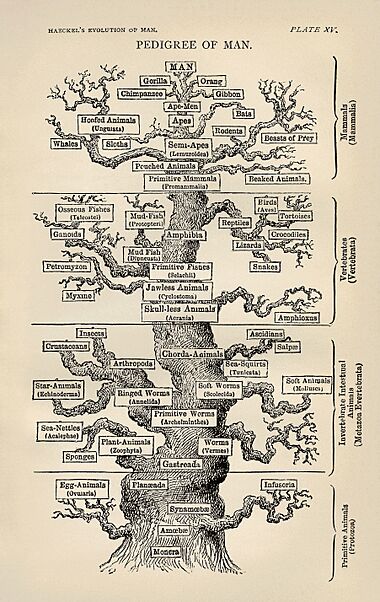
Contents
Ancient Ideas About Life Changing
Greek Thinkers and Early Ideas

Some of the earliest ideas that one type of animal, even humans, could come from other types of animals go back to ancient Greek philosophers. Anaximander of Miletus (around 610–546 BC) suggested that the first animals lived in water when Earth was wetter. He thought the first land-dwelling ancestors of humans must have been born in water and only later lived on land. He also believed that the first human, as we know them today, must have been the child of a different kind of animal, probably a fish. This was because human babies need a lot of care to survive.
Another philosopher, Empedocles, thought that what we call birth and death in animals is just different parts of elements mixing and separating. He believed the first animals and plants were like separate pieces of what we see today. Some of these pieces survived by joining together in different ways. If they joined in a way that worked well, they survived.
Other philosophers who became more famous at the time, like Plato and Aristotle, believed that all things, including living things, were fixed and designed by a divine power.
The biologist Ernst Mayr called Plato "the great antihero of evolutionism." This is because Plato believed in essentialism, also known as the "theory of Forms." This theory says that every natural object we see is an imperfect copy of an ideal, perfect form. For example, Plato thought that a creator made the universe and everything in it because he was good and wanted everything to be as much like him as possible. This idea, that all possible forms of life are needed for a perfect creation, greatly influenced Christian thinking. However, some historians say that the idea of species being fixed and unchangeable didn't become very important until the start of biological classification in the 1600s and 1700s.
Aristotle, who was Plato's student, was the most influential Greek philosopher in Europe. He was also the earliest natural historian whose detailed work has survived. His writings on biology came from his studies of nature around the island of Lesbos. Aristotle's works contain careful observations, which he fit into his own ideas about how the body works. He classified organisms in a hierarchical but static "Ladder of Life," or "great chain of being." He placed them according to how complex their structure and function were, with more active and mobile organisms described as "higher organisms." Aristotle believed that living things clearly showed they had a purpose, meaning their form suited their function. He disagreed with Empedocles' idea that living creatures might have appeared by chance.
Chinese Thinkers and Change
Ancient Chinese thinkers like Zhuang Zhou (around 369–286 BC), a Taoist philosopher, had ideas about biological species changing. According to Joseph Needham, Taoism clearly said that biological species are not fixed. Taoist philosophers thought that species developed different traits because of different environments. Taoism sees humans, nature, and the heavens as always changing, which is different from the more static view of nature common in Western thought.
Roman Empire Views
The poem De rerum natura by Lucretius explains the ideas of the Greek Epicurean philosophers very well. It describes how the universe, Earth, living things, and human society developed through natural processes, without any supernatural involvement. This poem influenced later thinkers during and after the Renaissance. This view was very different from Roman Stoic philosophers like Seneca the Younger and Pliny the Elder. They had a strong belief that the natural world was designed for a purpose, which influenced Christian beliefs.
Early Christian Thinkers
Some early Christian thinkers, known as Church Fathers, also had ideas that could be seen as related to evolution.
Origen of Alexandria
In the 200s AD, the Christian philosopher Origen of Alexandria believed that the creation story in the Book of Genesis should be understood as an allegory, not as a literal historical event. He wrote that it would be foolish to think that the first days of creation happened without the sun, moon, and stars, or that God literally planted a garden and walked in it. He thought these stories had deeper, symbolic meanings.
Gregory of Nyssa
Gregory of Nyssa wrote that the Bible shows God created things in a step-by-step way, leading up to humans. He said that after the universe was created, humans didn't appear right away. First came plants, then animals, and then humans. This showed that life forces mixed with matter in stages: first into non-living nature, then into living things that could feel, and then into intelligent beings.
Augustine of Hippo
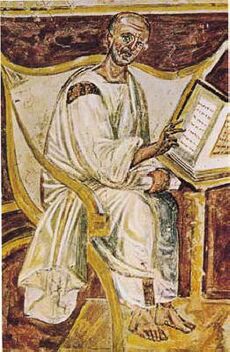
In the 300s AD, the bishop and theologian Augustine of Hippo also thought that Christians should read the Genesis creation story as an allegory. In his book On the Literal Meaning of Genesis, he said that all sacred books teach eternal truths, tell stories, predict future events, and give advice. He believed that the stories in the Bible often have a symbolic meaning.
Augustine also talked about a form of "theistic evolution." He suggested that God created things potentially, and then they appeared over time in different forms. This has led some modern scholars to believe Augustine supported a form of evolution guided by God. He also used the idea of rationes seminales (seed-like reasons) to combine the idea of divine creation with later development. This idea, that forms of life transformed "slowly over time," led some to say that Augustine had suggested a form of evolution.
Augustine also believed that whatever science shows, the Bible must teach. He wrote that it's embarrassing for a non-Christian to hear a Christian talk nonsense about science, especially when explaining the Bible. He thought it made people outside the faith criticize and reject the Bible's writers as uneducated.
Medieval Islamic Ideas
Islamic Philosophy and the Struggle for Life
While Greek and Roman evolutionary ideas faded in Western Europe after the fall of the Roman Empire, they were kept alive by Islamic philosophers and scientists. During the Islamic Golden Age (8th to 13th centuries), philosophers explored ideas about natural history. These ideas included the idea of things changing from non-living to living: "from mineral to plant, from plant to animal, and from animal to man."
In the 800s, the scholar al-Jahiz wrote his Book of Animals. He described a "struggle for existence," saying that "Every weak animal devours those weaker than itself. Strong animals cannot escape being devoured by other animals stronger than they." He also wrote about food chains.
Some of Ibn Khaldun's ideas, according to some experts, are similar to the biological theory of evolution. In 1377, Ibn Khaldūn wrote the Muqaddimah, where he said that humans developed from "the world of the monkeys" and that "species become more numerous." He also wrote that "The whole of existence... is arranged in a natural order of ascent and descent, so that everything constitutes an uninterrupted continuum." He suggested that things at the end of one stage are ready to change into the next stage, like plants changing into snails, or monkeys changing into humans.
Thomas Aquinas and Natural Processes
Most Christian thinkers believed that the natural world was part of an unchanging, designed order. However, some, like Thomas Aquinas, thought the world might have developed through natural processes. Aquinas built on Augustine's ideas, saying that God created everything potentially, and then things appeared over time in their different forms. He saw the independence of nature as a sign of God's goodness. He didn't see a conflict between a divinely created universe and the idea that the universe developed over time through natural means.
Renaissance and Enlightenment Ideas
In the early 1600s, René Descartes' idea of the universe as a machine encouraged people to think of it that way. Between 1650 and 1800, some naturalists, like Benoît de Maillet, suggested that the universe, Earth, and life developed mechanically, without God's direct guidance. In contrast, most evolutionary theories at the time, like those of Gottfried Leibniz, saw evolution as a spiritual process. In 1751, Pierre Louis Maupertuis leaned more towards materialistic ideas. He wrote about natural changes happening during reproduction and building up over many generations, creating new types and even new species. This was an early idea similar to natural selection.
Maupertuis' ideas were different from those of early classifiers like John Ray. In the late 1600s, Ray defined a biological species as having fixed, unchanging features. He said that the seed of one species could never create another. These ideas were influenced by the belief that nature showed God's design.
The word "evolution" (from Latin evolutio, meaning "to unroll") was first used for how embryos develop. Its first use for the development of species was in 1762, when Charles Bonnet used it for his idea of "pre-formation," where females carried tiny forms of all future generations. The term gradually came to mean growth or progressive development.
Later in the 1700s, the French philosopher Georges-Louis Leclerc, Comte de Buffon, a leading naturalist, suggested that what people called species were just different types that had changed from an original form due to the environment. For example, he thought lions, tigers, leopards, and house cats might all share a common ancestor. He even guessed that the 200 mammal species known then might have come from as few as 38 original animal forms. Buffon's evolutionary ideas were limited; he thought each original form appeared by itself and was shaped by "internal molds" that limited how much it could change. His books, Histoire naturelle (1749–1789) and Époques de la nature (1778), had well-developed theories about a completely materialistic origin for Earth and questioned the fixity of species. These books were very influential.
Another French philosopher, Denis Diderot, also wrote that living things might have first appeared by themselves. He thought species were always changing through a process of trial and error, where new forms appeared and either survived or not. This idea can be seen as an early version of natural selection. Between 1767 and 1792, James Burnett, Lord Monboddo, wrote that humans came from primates and that creatures changed their traits over long periods in response to the environment. Charles Darwin's grandfather, Erasmus Darwin, published Zoonomia (1794–1796), suggesting that "all warm-blooded animals have arisen from one living filament." In his poem Temple of Nature (1803), he described life rising from tiny organisms in mud to all its modern diversity.
Early 1800s: Fossils and Change
Paleontology and Geology Discoveries
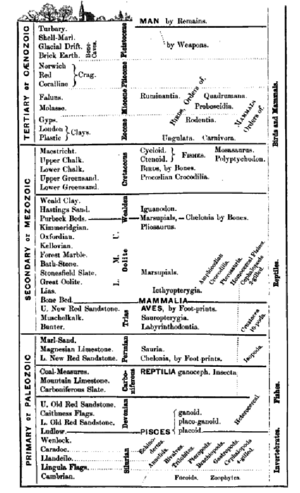
In 1796, Georges Cuvier published his findings on the differences between living elephants and those found as fossils. His study showed that mammoths and mastodons were distinct species, different from any living animal. This effectively ended a long debate about whether a species could go extinct. In 1788, James Hutton described gradual geological processes happening continuously over very long periods. In the 1790s, William Smith started organizing rock layers by looking at the fossils in them while making his geologic map of England. In 1811, Cuvier and Alexandre Brongniart published an important study of the geological history around Paris, based on the layers of rock. These works helped establish that Earth was very old. Cuvier believed in catastrophism, which meant that patterns of extinction and new animal groups appearing in the fossil record were due to repeated sudden, violent events.
Knowledge of fossils continued to grow quickly in the early 1800s. By the 1840s, the main parts of the geologic timescale were becoming clear. In 1841, John Phillips named three main eras based on the main animals of each: the Paleozoic (mostly sea invertebrates and fish), the Mesozoic (the age of reptiles), and the current Cenozoic (age of mammals). This idea of life progressing was accepted even by conservative English geologists. However, like Cuvier, they thought this progression was due to repeated catastrophes followed by new creations.
From 1830 to 1833, geologist Charles Lyell published his multi-volume work Principles of Geology. Building on Hutton's ideas, Lyell argued for uniformitarianism, which was an alternative to the catastrophic theory. Lyell said that Earth's geological features were not caused by sudden, violent events, but by the same gradual geological forces we see today, acting over incredibly long periods. Even though Lyell was against evolutionary ideas, his concept of a very old Earth shaped by slow forces greatly influenced future evolutionary thinkers like Charles Darwin.
Species Changing Over Time
Jean-Baptiste Lamarck proposed his theory of the "transmutation of species" in 1809. Lamarck didn't think all living things shared a common ancestor. Instead, he believed that simple life forms were constantly created by themselves. He also thought that an inner "life force" made species become more complex over time, moving up a linear ladder of complexity. Lamarck recognized that species adapted to their environment. He explained this by saying that the same inner force that made things more complex also caused an animal's organs to change based on whether they were used or not, just like exercise affects muscles. He argued that these changes would be passed down to the next generation, leading to slow adaptation to the environment. This idea of adaptation through the inheritance of acquired characteristics became known as Lamarckism.
A group of British anatomists, including Robert Edmond Grant, were in close contact with Lamarck's French ideas. Grant studied the anatomy and reproduction of marine invertebrates. He developed Lamarck's and Erasmus Darwin's ideas of change and evolution. He even suggested that plants and animals had a common evolutionary starting point. As a young student, Charles Darwin joined Grant in studying marine animals. In 1826, a paper, probably by Robert Jameson, praised Lamarck for explaining how higher animals had "evolved" from simple worms. This was one of the first times the word "evolved" was used in a modern sense.
In 1844, the Scottish publisher Robert Chambers anonymously published a very controversial but widely read book called Vestiges of the Natural History of Creation. This book suggested an evolutionary story for how the Solar System and life on Earth began. It claimed that fossils showed animals progressively getting more complex, with current animals branching off a main line that leads to humanity. It implied that these changes were part of a pre-planned design built into the laws of the universe. The strong public debate over Vestiges, which showed evolution as a progressive process, greatly influenced how Darwin's theory was seen a decade later.
Ideas about species changing were linked to radical materialistic ideas of the Enlightenment and were attacked by more conservative thinkers. Cuvier attacked Lamarck's ideas, agreeing with Aristotle that species were unchangeable. Cuvier believed that an animal's parts were too connected to allow one part to change without affecting others. He also argued that the fossil record showed patterns of catastrophic extinctions followed by new populations, rather than gradual change. He also noted that drawings of animals and animal mummies from Egypt, thousands of years old, showed no changes compared to modern animals. Cuvier's strong arguments and scientific reputation kept ideas about species changing out of the mainstream for decades.
In Britain, the idea of natural theology remained influential. William Paley's 1802 book Natural Theology, with its famous watchmaker analogy, was partly written to respond to Erasmus Darwin's ideas about change. Geologists influenced by natural theology often attacked the evolutionary ideas of Lamarck and others. Although Charles Lyell was against religious geology, he also believed species were unchangeable. Idealists like Louis Agassiz and Richard Owen believed that each species was fixed because it represented an idea in the creator's mind. They thought relationships between species could be seen in how embryos develop and in fossils, but that these relationships showed a divine plan, with creation leading to more complexity and ending with humanity. Owen developed the idea of "archetypes" in the Divine mind that would produce a sequence of species related by similar body parts, like vertebrate limbs. Owen led a public campaign that successfully pushed Grant out of the scientific community. Darwin would use the similarities analyzed by Owen in his own theory. However, the harsh treatment of Grant and the controversy around Vestiges showed Darwin that his own ideas needed to be scientifically strong.
Early Ideas Like Natural Selection
It's possible to find early ideas similar to almost all of Charles Darwin's key concepts throughout the history of biology. For example, Loren Eiseley found passages by Buffon that suggested he was almost ready to put together a theory of natural selection. However, such early ideas shouldn't be taken out of context, as the cultural values of the time often made Darwinian ideas unthinkable.
When Darwin was developing his theory, he studied selective breeding and was impressed by John Sebright's observation that "A severe winter, or a scarcity of food, by destroying the weak and the unhealthy, has all the good effects of the most skilful selection." This meant that "the weak and the unhealthy do not live to propagate their infirmities." Darwin was influenced by Charles Lyell's ideas that environmental changes cause shifts in living things, leading to what Augustin de Candolle called a "war" between competing plant species. Darwin was also struck by Thomas Robert Malthus's phrase "struggle for existence," which Malthus used for warring human tribes.
Several writers had ideas that were similar to parts of Darwin's theory. In the third edition of On the Origin of Species (1861), Darwin named those he knew about in an introduction called An Historical Sketch of the Recent Progress of Opinion on the Origin of Species.
In 1813, William Charles Wells read essays to the Royal Society that assumed humans had evolved and recognized the principle of natural selection. Darwin and Alfred Russel Wallace didn't know about this work when they published their theory together in 1858. But Darwin later admitted that Wells had recognized the principle before them.
Patrick Matthew wrote in his 1831 book On Naval Timber and Arboriculture about "continual balancing of life to circumstance." He suggested that offspring from the same parents, under very different conditions, could become distinct species over several generations. Darwin found this work after his Origin was first published.
However, as historian of science Peter J. Bowler says, "Through a combination of bold theorizing and comprehensive evaluation, Darwin came up with a concept of evolution that was unique for the time." Bowler adds that simply being first isn't enough; someone has to develop an idea and convince others of its importance to have a real impact.
Natural Selection: Darwin's Big Idea
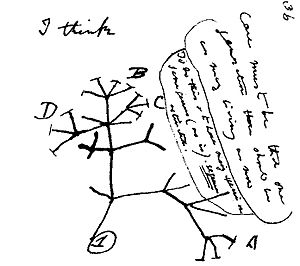
The patterns of living things that Charles Darwin saw in places like the Galápagos Islands during his voyage on HMS Beagle made him doubt that species were fixed. In 1837, Darwin started a series of secret notebooks on how species change. Darwin's observations led him to see change as a process of branching and diverging, not a ladder-like progression as Lamarck imagined. In 1838, he read the book An Essay on the Principle of Population by Thomas Robert Malthus. Malthus's idea that population growth leads to a struggle for survival, combined with Darwin's knowledge of how breeders select traits, led to Darwin's theory of natural selection.
Darwin didn't publish his ideas on evolution for 20 years. However, he shared them with other naturalists and friends, starting with Joseph Dalton Hooker. During this time, he slowly refined his ideas and gathered evidence to support them, knowing how controversial the idea of species changing was. In September 1854, he began working full-time on his book about natural selection.
Unlike Darwin, Alfred Russel Wallace, influenced by the book Vestiges of the Natural History of Creation, already suspected that species changed when he started his career as a naturalist. By 1855, his observations during his work in South America and the Malay Archipelago made him confident enough in a branching pattern of evolution to publish a paper. Like Darwin, Wallace's thoughts on how Malthus's ideas applied to animal populations led him to similar conclusions about natural selection. In February 1858, Wallace, unaware of Darwin's unpublished ideas, wrote an essay and sent it to Darwin, asking for his opinion. The result was the joint publication in July of an extract from Darwin's 1844 essay along with Wallace's letter. Darwin then started working on a short summary of his theory, which he published in 1859 as On the Origin of Species.
1859–1930s: Darwin's Impact
Acceptance of Evolution
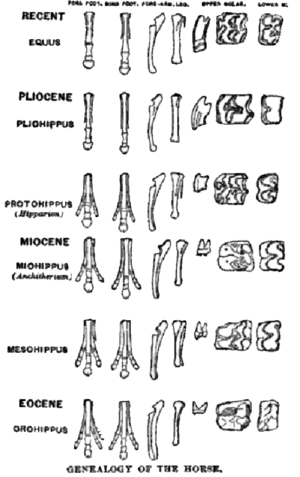
By the 1850s, whether species evolved was a big debate among scientists. Charles Darwin's On the Origin of Species completely changed this discussion. Darwin argued that his branching idea of evolution explained many facts in how animals are spread, their anatomy, how embryos develop, and other areas of biology. He also provided the first clear way for evolutionary change to happen and last: his theory of natural selection.
One of the first and most important naturalists to be convinced by Origin was the British anatomist Thomas Henry Huxley. Huxley saw that unlike earlier ideas, Darwin's theory provided a way for evolution without supernatural involvement. Huxley made advocating for evolution a main goal of his group, the X Club, to make science more professional and replace natural theology with naturalism. By the early 1870s in English-speaking countries, evolution became the main scientific explanation for how species originated. In his effort to get Darwin's theory accepted, Huxley used new fossil evidence for evolution. This included evidence that birds evolved from reptiles, like the discovery of Archaeopteryx in Europe, and fossils of early birds with teeth found in North America. Another important piece of evidence was fossils that helped trace the evolution of the horse from its small, five-toed ancestors.
Applying Evolution to Humans
Charles Darwin knew about the strong negative reactions from some scientists to the idea in Vestiges of the Natural History of Creation that humans came from animals. So, he almost completely avoided the topic of human evolution in On the Origin of Species. Despite this, the issue was a big part of the debate after his book was published. For most of the early 1800s, scientists believed that humans appeared suddenly only a few thousand years ago. However, archaeological discoveries in the 1840s and 1850s showed stone tools with the remains of extinct animals. By the early 1860s, it was widely accepted that humans had existed for many thousands of years before written history. This view of human history fit better with an evolutionary origin for humanity.
The debate after On the Origin of Species focused on the similarities and differences between humans and modern apes. Carl Linnaeus had been criticized in the 1700s for putting humans and apes together as primates in his classification system. Richard Owen strongly defended the idea that humans were in a separate group from other mammals. On the other hand, Thomas Henry Huxley tried to show a close anatomical relationship between humans and apes. Huxley summarized his arguments in his influential 1863 book Evidence as to Man's Place in Nature.
In 1871, Darwin published The Descent of Man, and Selection in Relation to Sex, which contained his views on human evolution. Darwin argued that the differences between the human mind and the minds of higher animals were a matter of degree, not a completely different kind. For example, he saw morality as a natural result of instincts that were good for animals living in social groups. He argued that all the differences between humans and apes could be explained by the selective pressures from our ancestors moving from trees to plains, and by sexual selection. The debate over human origins and human uniqueness continued well into the 1900s.
Other Ideas Besides Natural Selection
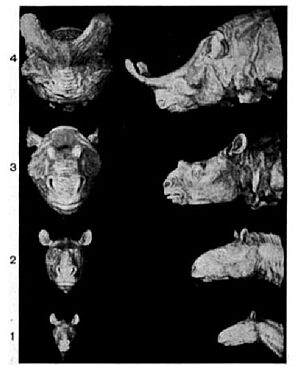
The idea of evolution was widely accepted in science within a few years of Origin being published. However, natural selection as the main driving force was much less accepted. The four main alternatives to natural selection in the late 1800s were:
- Theistic evolution: The idea that God guided the process of evolution so that the living world could still be seen as designed. This idea gradually became less popular among scientists.
- Neo-Lamarckism: This view focused on the inheritance of acquired characteristics as the most important way evolution happened. Supporters included Ernst Haeckel and Edward Drinker Cope. Critics pointed out that there was no strong evidence for acquired characteristics being inherited.
- Orthogenesis: The idea that life has an inner tendency to change in a straight line towards greater perfection. This was popular among some paleontologists who believed that fossils showed a gradual, constant, one-way change.
- Saltationism: The idea that new species appear as a result of large, sudden changes (mutations). This was seen as a much faster way for evolution to happen than Darwin's gradual process. It was popular with early geneticists like Hugo de Vries and William Bateson.
Mendel's Genetics and Mutation
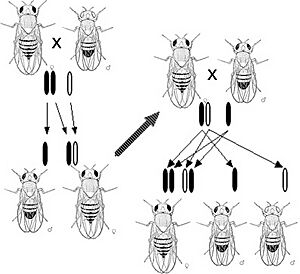
The rediscovery of Gregor Mendel's laws of inheritance in 1900 started a big debate between two groups of biologists. One group, the Mendelians, focused on distinct variations and inheritance laws. They were led by William Bateson (who created the word "genetics") and Hugo de Vries (who created the word "mutation"). Their opponents were the biometricians, who were interested in the continuous variation of traits within populations. They followed Francis Galton, who focused on measuring and statistically analyzing variation. The biometricians rejected Mendelian genetics because they thought discrete units of heredity, like genes, couldn't explain the continuous range of variation seen in real populations.
When Thomas Hunt Morgan started experimenting with breeding fruit flies, he was a saltationist who hoped to show that a new species could be created in the lab by mutation alone. Instead, his work between 1910 and 1915 reconfirmed Mendelian genetics and provided strong experimental evidence linking it to how chromosomes pass on traits. His work also showed that most mutations had small effects, like a change in eye color. Rather than creating a new species in one step, mutations increased variation within the existing population.
1920s–1940s: The Modern Synthesis
Population Genetics Emerges
The ideas of Mendelians and biometricians were eventually brought together with the development of population genetics. A key step was the work of the British biologist and statistician Ronald Fisher. In a series of papers starting in 1918 and ending with his 1930 book The Genetical Theory of Natural Selection, Fisher showed that the continuous variation measured by the biometricians could be caused by many discrete genes working together. He also showed that natural selection could change gene frequencies in a population, leading to evolution. In papers starting in 1924, another British geneticist, J. B. S. Haldane, used statistics to analyze real-world examples of natural selection, like the evolution of dark coloration in peppered moths in industrial areas. He showed that natural selection worked even faster than Fisher had thought.
The American biologist Sewall Wright, who had experience with animal breeding, focused on combinations of interacting genes and the effects of inbreeding on small, isolated populations that showed genetic drift. In 1932, Wright introduced the idea of an "adaptive landscape." He argued that genetic drift and inbreeding could move a small, isolated sub-population away from a peak of adaptation, allowing natural selection to push it towards different peaks. The work of Fisher, Haldane, and Wright founded the field of population genetics. This field combined natural selection with Mendelian genetics, which was the crucial first step in creating a unified theory of how evolution works.
The Modern Synthesis of Evolution
In the early 1900s, most naturalists still believed that other ways of evolution, like Lamarckism, best explained the complexity they saw in the living world. But as genetics continued to develop, those views became less likely. Theodosius Dobzhansky, a researcher in Thomas Hunt Morgan's lab, was influenced by the work on genetic diversity by Russian geneticists. He helped connect the small-scale evolution (microevolution) studied by population geneticists with the large-scale patterns of evolution (macroevolution) observed by field biologists, with his 1937 book Genetics and the Origin of Species. Dobzhansky studied the genetic diversity of wild populations and showed that, contrary to what population geneticists assumed, these populations had a lot of genetic diversity, with clear differences between sub-populations. His book also made the highly mathematical work of population geneticists easier to understand.
The evolutionary biologist Ernst Mayr was influenced by the work of the German biologist Bernhard Rensch, which showed how local environmental factors influenced where different sub-species and closely related species lived. Mayr followed up on Dobzhansky's work with his 1942 book Systematics and the Origin of Species. This book stressed the importance of allopatric speciation (when new species form because populations are geographically separated) in the creation of new species. Mayr also created the biological species concept, which defines a species as a group of populations that can interbreed or potentially interbreed and are reproductively isolated from all other populations.
In the 1944 book Tempo and Mode in Evolution, George Gaylord Simpson showed that the fossil record matched the irregular, non-directional pattern predicted by the developing evolutionary synthesis. He also showed that the linear trends that earlier paleontologists claimed supported orthogenesis and neo-Lamarckism didn't hold up to closer examination. In 1950, G. Ledyard Stebbins published Variation and Evolution in Plants, which helped bring botany into the synthesis. This growing agreement across different scientific fields on how evolution works became known as the modern synthesis. It got its name from the 1942 book Evolution: The Modern Synthesis by Julian Huxley.
The modern synthesis provided a central idea—especially natural selection and Mendelian population genetics—that connected many, but not all, biological fields. It helped establish evolutionary biology, which is mainly a historical science, in a scientific world that preferred experimental methods. The synthesis also narrowed down the range of mainstream evolutionary thought. By the 1950s, natural selection acting on genetic variation was almost the only accepted way for evolutionary change to happen, and large-scale evolution was simply seen as the result of many small-scale evolutionary changes.
1940s–1960s: Genes and Evolution
Molecular Biology and Evolution
The middle of the 1900s saw the rise of molecular biology. With it came an understanding of genes as sequences of DNA and how they relate to protein sequences through the genetic code. More powerful ways to analyze proteins, like protein electrophoresis and sequencing, brought biochemical events into the theory of evolution. In the early 1960s, biochemists Linus Pauling and Emile Zuckerkandl proposed the molecular clock hypothesis. This idea suggested that differences in protein sequences between similar proteins could be used to calculate how long ago two species separated. By 1969, Motoo Kimura and others provided a theoretical basis for the molecular clock. They argued that, at the molecular level, most genetic mutations are neither harmful nor helpful. They believed that mutation and genetic drift (rather than natural selection) cause a large part of genetic change. This was called the neutral theory of molecular evolution. Studies of protein differences within species also added molecular data to population genetics by estimating the level of genetic variation in natural populations.
From the early 1960s, molecular biology was increasingly seen as a challenge to the traditional core of evolutionary biology. Established evolutionary biologists, especially Ernst Mayr, Theodosius Dobzhansky, and George Gaylord Simpson, were very doubtful about molecular approaches, especially their connection (or lack of it) to natural selection. The molecular-clock hypothesis and the neutral theory were particularly controversial. They started the "neutralist-selectionist debate" about how important mutation, drift, and selection were, which continued into the 1980s without a clear answer.
Late 20th Century: New Perspectives
Gene-Centered View of Evolution
In the mid-1960s, George C. Williams strongly criticized explanations of adaptations that talked about "survival of the species." These "group selection" arguments were largely replaced by a gene-centered view of evolution. This view was best shown by the kin selection arguments of W. D. Hamilton, George R. Price, and John Maynard Smith. This viewpoint was summarized and made popular in the influential 1976 book The Selfish Gene by Richard Dawkins. Models at the time seemed to show that group selection was very limited in its strength.
In 1973, Leigh Van Valen proposed the term "Red Queen," from Through the Looking-Glass by Lewis Carroll. This described a situation where a species in an "evolutionary arms race" would have to constantly change to keep up with the species it was evolving with. Hamilton, Williams, and others suggested that this idea might explain the evolution of sexual reproduction. The increased genetic diversity from sexual reproduction would help organisms resist rapidly evolving parasites, making sexual reproduction common despite its high cost from a gene-centric point of view.
The gene-centric view also led to more interest in Charles Darwin's idea of sexual selection.
Sociobiology and Behavior
W. D. Hamilton's work on kin selection helped create the field of sociobiology. The existence of altruistic behaviors (acting unselfishly) has been a difficult problem for evolutionary theorists. Big progress was made in 1964 when Hamilton created a rule in kin selection, known as Hamilton's rule. This rule showed how eusociality in insects (like sterile worker classes) and other examples of altruistic behavior could have evolved through kin selection. Other theories followed, some from game theory, like reciprocal altruism. In 1975, E. O. Wilson published the influential and very controversial book Sociobiology: The New Synthesis. This book claimed that evolutionary theory could help explain many aspects of animal, including human, behavior. Critics of sociobiology, like Stephen Jay Gould and Richard Lewontin, argued that sociobiology greatly exaggerated how much complex human behaviors could be determined by genes. They also claimed that sociobiologists' theories often reflected their own biases. Despite these criticisms, work has continued in sociobiology and the related field of evolutionary psychology.
Evolutionary Paths and Processes
One of the most important debates in the 1970s was about the theory of punctuated equilibrium. Niles Eldredge and Stephen Jay Gould suggested that fossil species often stayed mostly unchanged for long periods (called stasis). These periods were broken up by relatively short times of rapid change during the formation of new species. Improvements in DNA sequencing methods led to a large increase in sequenced genomes. This allowed scientists to test and refine evolutionary theories using this huge amount of genome data. Comparing these genomes provides insights into how new species form and how organisms adapt at a molecular level. These genomic analyses have fundamentally changed our understanding of evolutionary history, such as the proposal of the three-domain system by Carl Woese. Advances in computers allow scientists to test and expand increasingly advanced evolutionary models and develop the field of systems biology. One result has been an exchange of ideas between theories of biological evolution and computer science, leading to "evolutionary computation," which tries to copy biological evolution to create new computer algorithms. Discoveries in biotechnology now allow scientists to modify entire genomes, advancing evolutionary studies to the point where future experiments might involve creating entirely synthetic organisms.
Microbes, Gene Transfer, and Symbiosis
Microbiology was largely ignored by early evolutionary theory because there were few visible traits and no clear species concept for microbes, especially among prokaryotes. Now, evolutionary researchers are using their better understanding of microbial biology and ecology, made easier by how simple it is to study microbial genomes, to explore how these organisms are classified and how they evolved. These studies are showing unexpected levels of diversity among microbes.
An important development in the study of microbial evolution came with the discovery of horizontal gene transfer in Japan in 1959. This transfer of genetic material between different species of bacteria caught scientists' attention because it played a major role in the spread of antibiotic resistance. More recently, as knowledge of genomes has grown, it has been suggested that lateral transfer of genetic material has played an important role in the evolution of all organisms. These high levels of horizontal gene transfer have led to suggestions that the family tree of today's organisms, the "tree of life," is more like an interconnected web.
The endosymbiotic theory for the origin of organelles (parts of cells) sees a form of horizontal gene transfer as a critical step in the evolution of eukaryotes (cells with a nucleus). The endosymbiotic theory suggests that organelles within eukaryotic cells, like mitochondria and chloroplasts, came from independent bacteria that started living together inside other cells. This idea was suggested in the late 1800s when similarities between mitochondria and bacteria were noticed, but it was mostly ignored until it was brought back and championed by Lynn Margulis in the 1960s and 1970s. Margulis was able to use new evidence that such organelles had their own DNA, which was inherited separately from the cell's nucleus.
From Spandrels to Evo-Devo
In the 1980s and 1990s, the ideas of the modern evolutionary synthesis came under more scrutiny. There was a renewed interest in structuralist ideas in evolutionary biology. This included the work of biologists like Brian Goodwin and Stuart Kauffman, who used ideas from cybernetics and systems theory. They emphasized that the self-organizing processes of development were factors guiding evolution. The evolutionary biologist Stephen Jay Gould brought back earlier ideas of heterochrony (changes in the relative rates of developmental processes over evolution) to explain how new forms appear. With the evolutionary biologist Richard Lewontin, he wrote an influential paper in 1979 suggesting that a change in one biological structure, or even a new structure, could appear by chance as an accidental result of selection on another structure, rather than direct selection for that specific adaptation. They called such accidental structural changes "spandrels" after an architectural feature. Later, Gould and Elisabeth Vrba discussed how new functions could be gained by new structures appearing this way, calling them "exaptations."
Molecular data about how development works grew quickly in the 1980s and 1990s. It became clear that the variety of animal body forms was not due to different sets of proteins controlling the development of different animals. Instead, it was from changes in how a small set of proteins, common to all animals, were used. These proteins became known as the "developmental-genetic toolkit." These ideas influenced the fields of phylogenetics (study of evolutionary relationships), paleontology, and comparative developmental biology, and created the new field of evolutionary developmental biology (evo-devo).
21st Century: New Insights
Big and Small Scale Evolution
One of the main ideas of population genetics is that macroevolution (evolution of groups above the species level) was only the result of microevolution (changes in gene frequency within populations) happening over a long time. In the last decades of the 1900s, some paleontologists questioned whether other factors, like punctuated equilibrium and group selection acting on entire species, needed to be considered to explain patterns in evolution seen in fossil records. Some researchers in evolutionary developmental biology suggested that interactions between the environment and the developmental process might have caused some of the new structures seen in macroevolution. However, other evo-devo researchers maintained that genetic mechanisms seen at the population level are enough to explain all macroevolution.
Epigenetic Inheritance
Epigenetics is the study of changes in how genes are expressed or how cells behave, caused by things other than changes in the DNA sequence itself. By the early 2000s, it was accepted that epigenetic mechanisms were a necessary part of how cells become different types during evolution. Although epigenetics in multicellular organisms is usually thought to be involved in differentiation, with epigenetic patterns "reset" when organisms reproduce, there have been some observations of epigenetic changes being passed down through generations. This shows that in some cases, non-genetic changes to an organism can be inherited. Such inheritance may help with adapting to local conditions and affect evolution. Some have suggested that in certain cases, a form of Lamarckian evolution might occur.
Extended Evolutionary Ideas
The idea of an "extended evolutionary synthesis" adds new concepts and mechanisms to the 20th-century modern synthesis. These include multilevel selection theory (selection at different levels, like groups), transgenerational epigenetic inheritance, niche construction (organisms changing their environment), and evolvability (how easily an organism can evolve). However, several different such syntheses have been proposed, with no full agreement on what exactly would be included.
See also
 In Spanish: Historia del pensamiento evolucionista para niños
In Spanish: Historia del pensamiento evolucionista para niños
- Current research topics in evolutionary biology
- Darwinism
- Faith and rationality
- Galápagos Islands
- Genetic drift
- Objections to evolution
- Timeline of evolutionary history of life
- The Voyage of the Beagle


